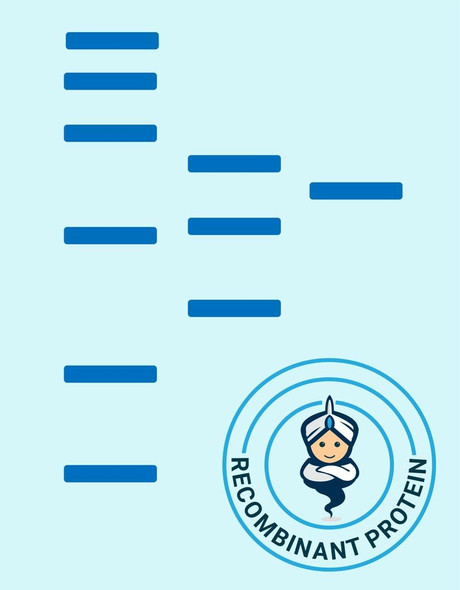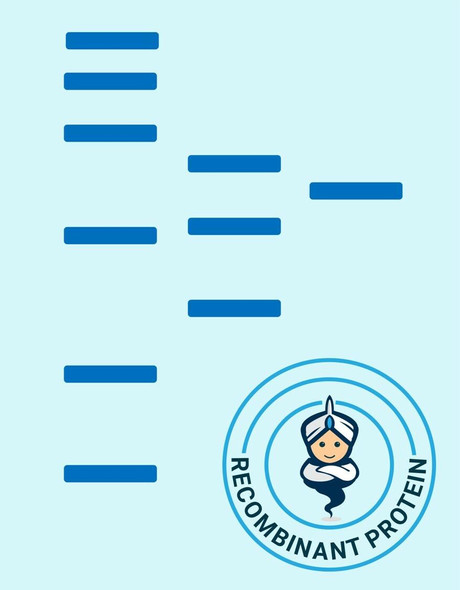Description
| Product Name: | Human EGLN3 Recombinant Protein |
| Product Code: | RPPB3417 |
| Size: | 10µg |
| Species: | Human |
| Target: | EGLN3 |
| Synonyms: | Egl nine homolog 3 (C. elegans), Hypoxia-inducible factor prolyl hydroxylase 3, Prolyl hydroxylase domain-containing protein 3, HIF-PH3, PHD3, egl nine-like protein 3 isoform, HIF prolyl hydroxylase 3, EC 1.14.11.29, HPH-1, HPH-3. |
| Source: | Escherichia Coli |
| Physical Appearance: | Sterile Filtered colorless solution. |
| Formulation: | The EGLN3 solution (0.25mg/1ml) contains 20mM Tris-HCl buffer (pH 8.0), 300mM NaCl, 5mM DTT, 2mM EDTA and 50% glycerol. |
| Stability: | Store at 4°C if entire vial will be used within 2-4 weeks. Store, frozen at -20°C for longer periods of time. For long term storage it is recommended to add a carrier protein (0.1% HSA or BSA).Avoid multiple freeze-thaw cycles. |
| Purity: | Greater than 90% as determined by SDS-PAGE. |
| Amino Acid Sequence: | MGSSHHHHHH SSGLVPRGSH MGSHMPLGHI MRLDLEKIAL EYIVPCLHEV GFCYLDNFLG EVVGDCVLER VKQLHCTGAL RDGQLAGPRA GVSKRHLRGD QITWIGGNEE GCEAISFLLS LIDRLVLYCG SRLGKYYVKE RSKAMVACYP GNGTGYVRHV DNPNGDGRCI TCIYYLNKNW DAKLHGGILR IFPEGKSFIA DVEPIFDRLL FFWSDRRNPH EVQPSYATRY AMTVWYFDAE ERAEAKKKFR NLTRKTESAL TED |
Egl Nine Homolog 3 (EGLN3) belongs to the EGLN family of prolyl hydroxylases. EGLN3 is the most significant isozyme in limiting physiological activation of HIFs (especially HIF2A) in hypoxia. EGLN3 is activated in cardiovascular cells and Hela cells after exposure to hypoxia. In addition, EGLN3 hydroxylates PKM2 in hypoxia, thus limiting glycolysis. Under normoxia, EGLN3 hydroxylates and regulates the stability of ADRB2. EGLN3 is inhibited by polynitrogen compounds possibly by chelation to Fe2+ ions.
EGLN3 Human Recombinant produced in E. coli is a single polypeptide chain containing 263 amino acids (1-239) and having a molecular mass of 29.8 kDa.EGLN3 is fused to a 24 amino acid His-tag at N-terminus & purified by proprietary chromatographic techniques.
| UniProt Protein Function: | EGLN3: Cellular oxygen sensor that catalyzes, under normoxic conditions, the post-translational formation of 4-hydroxyproline in hypoxia-inducible factor (HIF) alpha proteins. Hydroxylates a specific proline found in each of the oxygen-dependent degradation (ODD) domains (N-terminal, NODD, and C-terminal, CODD) of HIF1A. Also hydroxylates HIF2A. Has a preference for the CODD site for both HIF1A and HIF2A. Hydroxylation on the NODD site by EGLN3 appears to require prior hydroxylation on the CODD site. Hydroxylated HIFs are then targeted for proteasomal degradation via the von Hippel-Lindau ubiquitination complex. Under hypoxic conditions, the hydroxylation reaction is attenuated allowing HIFs to escape degradation resulting in their translocation to the nucleus, heterodimerization with HIF1B, and increased expression of hypoxy-inducible genes. EGLN3 is the most important isozyme in limiting physiological activation of HIFs (particularly HIF2A) in hypoxia. Also hydroxylates PKM in hypoxia, limiting glycolysis. Under normoxia, hydroxylates and regulates the stability of ADRB2. Regulator of cardiomyocyte and neuronal apoptosis. In cardiomyocytes, inhibits the anti-apoptotic effect of BCL2 by disrupting the BAX-BCL2 complex. In neurons, has a NGF-induced proapoptotic effect, probably through regulating CASP3 activity. Also essential for hypoxic regulation of neutrophilic inflammation. |
| UniProt Protein Details: | Protein type:Oxidoreductase; EC 1.14.11.29 Chromosomal Location of Human Ortholog: 14q13.1 Cellular Component: nucleoplasm; cytoplasm; nucleus; cytosol Molecular Function:protein binding; L-ascorbic acid binding; iron ion binding; oxidoreductase activity, acting on paired donors, with incorporation or reduction of molecular oxygen, 2-oxoglutarate as one donor, and incorporation of one atom each of oxygen into both donors; peptidyl-proline 4-dioxygenase activity Biological Process: caspase activation; apoptosis; regulation of neuron apoptosis; response to hypoxia; protein amino acid hydroxylation; peptidyl-proline hydroxylation to 4-hydroxy-L-proline; response to DNA damage stimulus; regulation of cell proliferation |
| UniProt Code: | Q9H6Z9 |
| NCBI GenInfo Identifier: | 32129515 |
| NCBI Gene ID: | 112399 |
| NCBI Accession: | Q9H6Z9.1 |
| UniProt Related Accession: | Q9H6Z9 |
| Molecular Weight: | Observed: 28 kDaPredicted: 28 kDa |
| NCBI Full Name: | Egl nine homolog 3 |
| NCBI Synonym Full Names: | egl-9 family hypoxia inducible factor 3 |
| NCBI Official Symbol: | EGLN3�� |
| NCBI Official Synonym Symbols: | PHD3; HIFPH3; HIFP4H3�� |
| NCBI Protein Information: | egl nine homolog 3 |
| UniProt Protein Name: | Egl nine homolog 3 |
| UniProt Synonym Protein Names: | HPH-1; Hypoxia-inducible factor prolyl hydroxylase 3; HIF-PH3; HIF-prolyl hydroxylase 3; HPH-3; Prolyl hydroxylase domain-containing protein 3; PHD3 |
| UniProt Gene Name: | EGLN3�� |
| UniProt Entry Name: | EGLN3_HUMAN |










